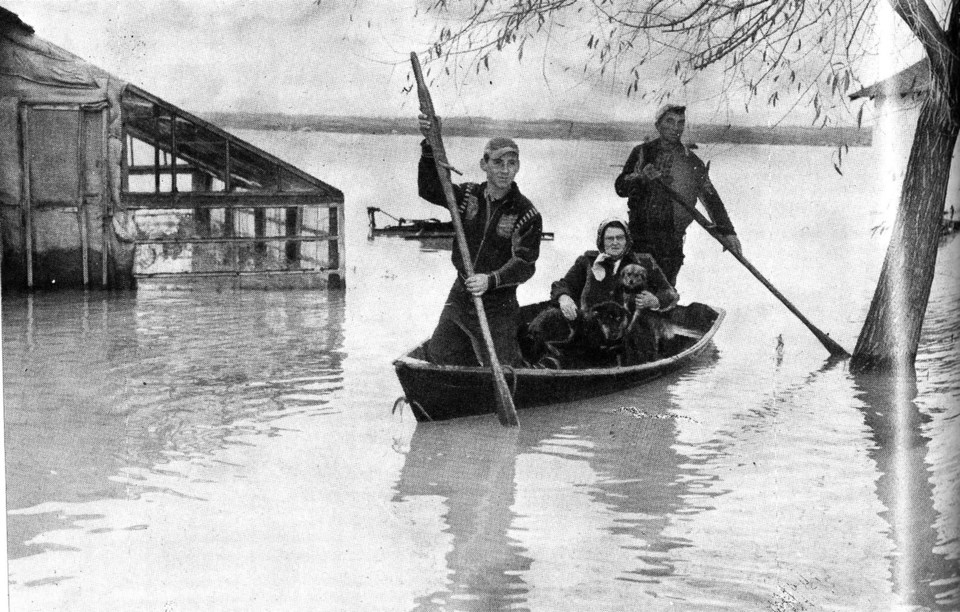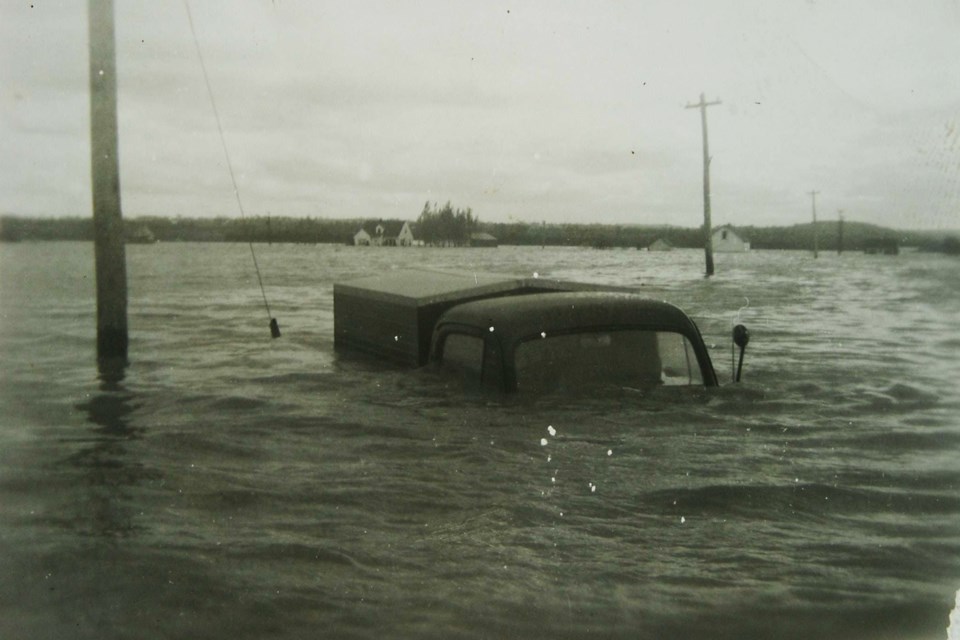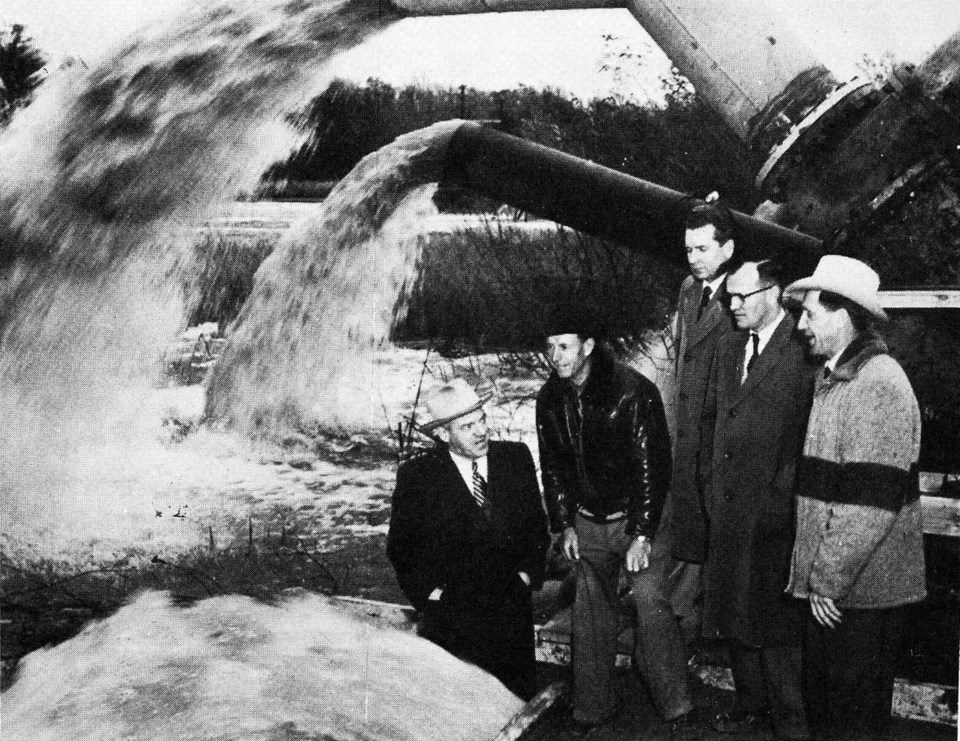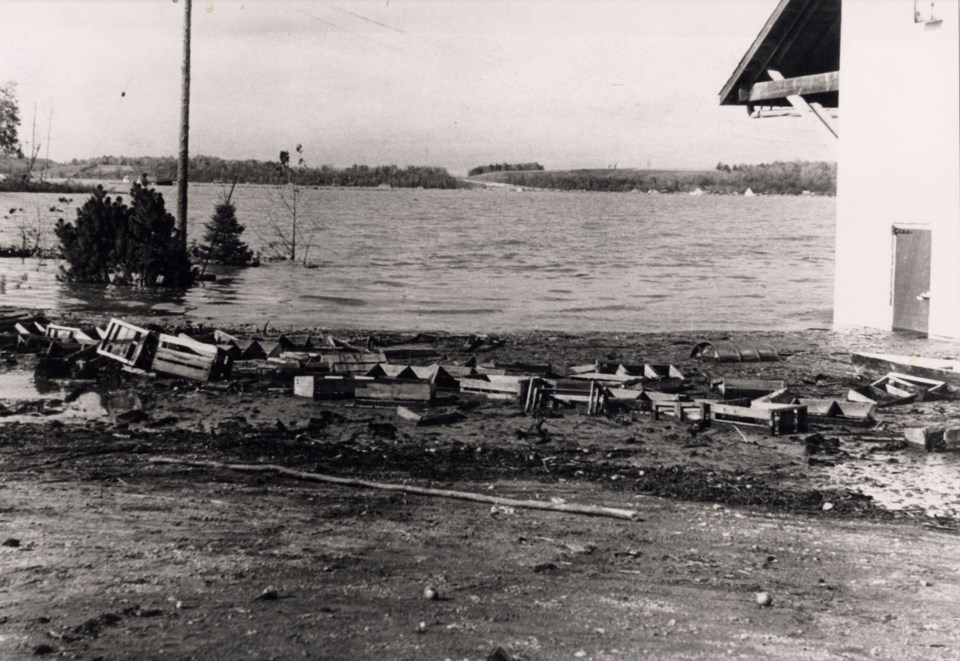“I lived through it.”
Art Janse remembers being 16 years old when the dykes burst in several places, watching as the water level in the basement of his family’s Holland Marsh home slowly continued to rise up the stairs, enveloping one step at a time and stopping just before the main floor.
That was 70 years ago on the evening of Oct. 15, 1954, when Hurricane Hazel pushed across southern Ontario, dumping more than 200 millimetres of rain on ground already saturated from previously wet weather, leading to flooding and the deaths of 81 people across the province according to Dalia Al-Ali, the manager of engineering services with the Nottawasaga Valley Conservation Authority.
Hazel battered the Caribbean before making landfall on the coast of South Carolina on Oct. 14, and meteorologists expected what was then a tropical storm to lose momentum or follow the eastern coast, Al-Ali explained in a column written earlier this year.
However, Hazel instead accelerated north through the Virginias and Pennsylvania toward Ontario, where it collided with another storm and a low-pressure system which “acted like fuel on an already raging fire” Al-Ali said.
Being up the hill, the town of Bradford was mostly spared, seeing “nearly no impact” according to Janse, but the low-lying marsh wasn’t so lucky.

Known in Bradford for his work as a councillor and his 36 years as marsh drainage superintendent from 1971 to 2007, Janse said his family was able to stay in their house overnight and weather the storm, but when they went outside the following morning they found “a lake that wasn’t there before.”
While their home near the north dyke saw flooding of about 1.5 metres, Janse recalled that in deeper areas near the Holland River, the water level was closer to four metres.
Things were particularly bad on the west side of Highway 400, which acted almost like a dam, while on the east side Janse recalled the water levels were only about one metre.
“You could say they built the highway through the best part of the marsh, but ... it saved the east side of the marsh from being severely flooded like it was on the west side,” Janse said.
By the morning, the water was high enough that it was running over the highway and flowing “full blast” through a roughly three-by-4.5-m culvert, which had to be closed off using vehicles, straw, and whatever else was available.

Historic photos show the tops of trucks poking out of the water, the Springdale Christian Reformed Church flooded almost to its windows and debris floating above fully submerged farms.
Other images show crews using boats to rescue people from homes that looked like islands and bring them to the highway or other high ground.
“The people in the town of Bradford were very supportive,” Janse said.
In addition to the rescue efforts, hot meals were also available at the town hall and Janse recalled different people around town opening their doors to those who needed a place to stay.
Most people who fled the impacted area spent the winter in an emergency trailer camp set up by the Rotary club where the community centre stands today, and the Canadian Mobile Home Association offered 200 trailers at a discounted price, according to reporting from the time in the Bradford Witness.
“The community all came together to make it happen,” Janse said. “It was as welcoming as you could get.”
Living closer to high ground, he and his family were able to follow the road to a neighbour’s farm where cars could be pulled up a hill, allowing the Janse family to make their way to Schomberg where they stayed with relatives.

After the storm blew out, Janse recalled it took about two or three days for the water levels to recede enough for the military to come in and repair the dykes, after which reports from the time in the Witness and Toronto Telegram show that even with numerous companies lending their equipment free of charge and pumping out as much as 265,000 litres of water per minute, it took until Nov. 13 for the marsh to completely drain back to the proper levels.
In the days immediately following Hazel, an emergency committee and relief fund were established to which then Premier Leslie Frost committed $100,000 while visiting, though flood losses were estimated to be between $10 million and $12 million, according to Witness reports from the time.
In the wake of Hazel, Janse said the dykes were eventually made taller and sturdier, while the canal was dug wider and deeper, as well as being rerouted in sections.
Impact in Innisfil
Neighbouring Innisfil may not have seen as much flooding, but it was by no means spared Hazel’s fury, with at least 25 centimetres of rain recorded in Gilford.
Born and raised in town, Donna Wice, the current president of the Innisfil Historical Society, recalled being about six or seven when Hurricane Hazel hit her family’s farmhouse on Line 9.
Sitting on the steps down to the basement with her two younger brothers, she watched “in amazement” as water poured in through the windows and a table where her mother used to work began to move about.
“The table was actually floating around at the bottom of the stairs with a jar of peaches on it,” Wice said.
Luckily, their bedrooms remained high and dry, but “in ’54 we had a basement full of water, and I’m sure for many others it was the same story.”
Some of those stories have been shared with the society over the years and included in its various publications including the 2020 Innisfil Review, Memories of Cookstown and Farms of Innisfil.
The latter contained a story about Peter and Elisabeth Duivenvoorden, who at the time had only recently moved to Innisfil from Holland and in their first year on their new farm planted mostly potatoes — all of which were flooded for a complete loss.
To make ends meet, Peter had to work for the township that winter burning brush from the sides of roads.
“The hurricane was so widespread and placed a lot of families in a destitute situation,” Wice explained, noting those sorts of jobs were offered as way to help people who were in “dire straights.”
Writing for the 2020 book, William Kell called Hazel “the most memorable weather event in Innisfil’s history,” noting that the town was “unprepared,” because in 1954, the “ability to predict weather and disseminate reports was limited.”
As a result, some parts of Innisfil suffered “considerable damage,” according to Kell, including flooded homes with ruined contents, damaged and broken bridges, plus vehicles and machinery with parts filled with water and covered in silt.
On top of that, the rail line was washed out in multiple locations, including at the Line 7 creek, Carson Creek, Line 3 Creek and Gilford Creek, which all lacked adequate culvert capacity according to Kell.

Bruce Webb shared a story of returning home from building a barn in Whitby with six co-workers in a truck on the evening of Oct. 15.
As they drove, they could see small houses floating alongside Highway 400, and the water on the road became deeper and deeper, until they eventually came across a couple stranded in a small car with “water nearly up to their necks.”
After using the truck to push the couple to higher ground, the group continued north.
“By the time we reached the Chatterbox (restaurant) at Highway 89, the road was washed out in so many places that we were forced to stay overnight,” Webb wrote.
They weren’t the only ones to encounter that problem, as roughly 350 people were reported to have been stranded at a service station in the area after a six-metre section of road had washed out south of Cookstown, according to Al-Ali.
Some spirits were too bright to be dampened by rain though, and Kell shared another story of a wedding that wouldn’t be stopped for anything — not even a hurricane.
The celebration of joining Blake Constable and Shirley Kell took place at the Gilford United Church on Oct. 16 with a reception for about 100 people at the Gilford Community Hall, despite Hazel having flooded the basement with about 10 centimetres of water.
“Gilford women do not give up easily,” Kell wrote.
He recalled Sadie Todd and the Gilford Women’s Institute donned their rubber boots to prepare the meals before carrying plates of food up the stairs to the main floor.
“Innisfil people are resilient, and they help one another. One only hopes that we still have that type of people around — caring sharing people that will assist when needed,” Wice said.
She’s not in a hurry to see another hurricane or storm necessitate that help anytime soon, though, and even if one were to come, improvements in drainage since the 1950s are intended to reduce the risk of flooding.
However, Innisfil was still dealing with flooded roads as recently as July thanks to the remnants of Hurricane Beryl.
“Let’s face it, in Innisfil we still have flooding ... It just shows you, there’s still drainage issues.” Wice said. “We’re never totally prepared for a disaster like that.”



